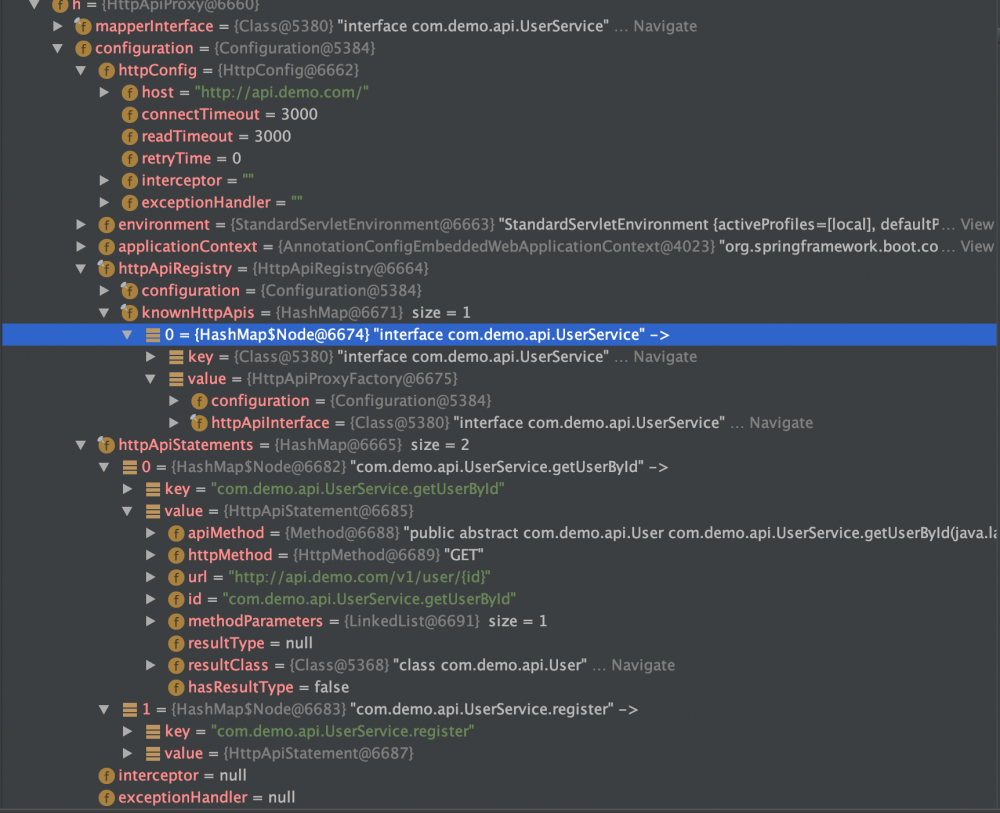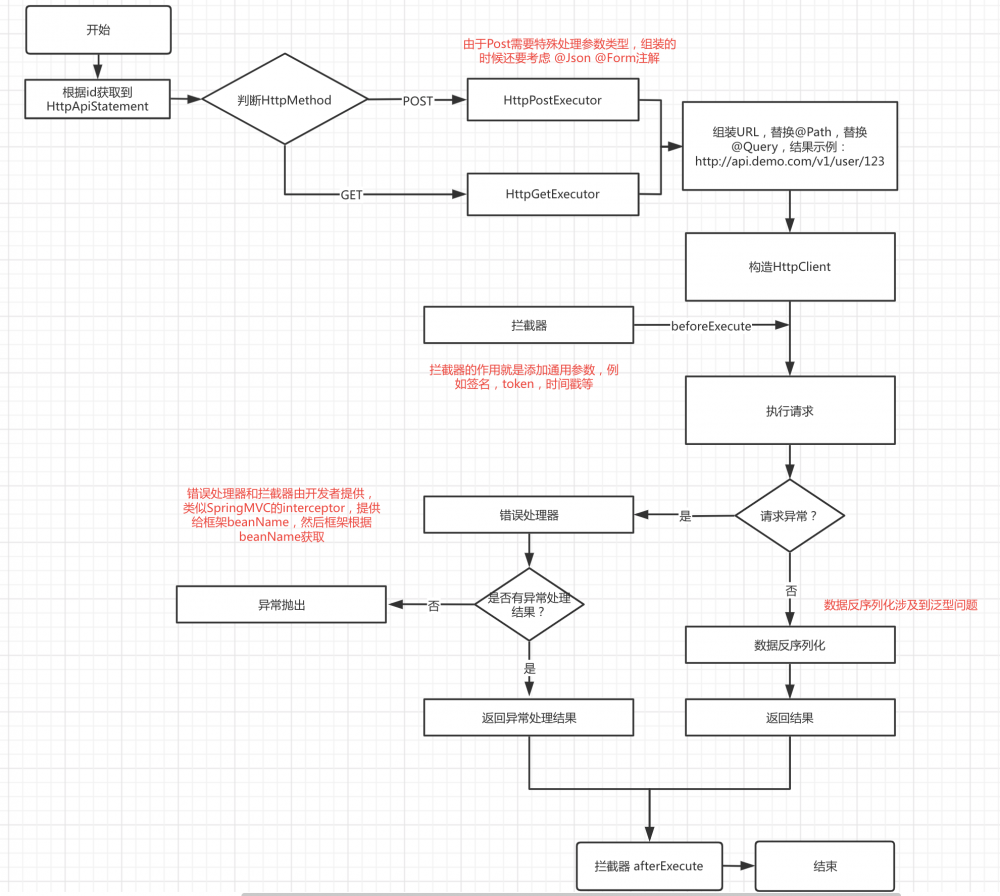一个关于HttpClient的轮子
由于本文较长,需要耐住性子阅读,另外本文中涉及到的知识点较多,想要深入学习某知识点可以参考其他博客或官网资料。本文也非源码分析文章,示例中的源码大多是伪代码和剪辑过的代码示例,由于该轮子为公司内部使用所以源码不便公开,敬请谅解。造轮子不重要,重要的是掌握轮子原理,取其精华,去其糟粕。欢迎大家拍砖。
背景
目前部门内部接口调用基本都是基于Http的,并且部门内部也有封装好的HttpClient。即便如此,每次有新的项目也要写一些繁琐的请求代码,即使不写也是复制粘贴,体验不算太好。于是乎想造一个轮子使用,为什么说是造轮子呢?因为它的功能和SpringCloud的OpenFeign差不多,不过由于是自己项目使用,自然是没有OpenFeign功能强大。
原理
用过MyBatis的同学应该都知道Mapper,所以此次造轮子我借鉴(抄袭)了Spring-Mybatis的部分代码,而且也是先把它的代码大致过了一遍才开始动工,大概要掌握的知识有如下几点:
- 动态代理
- Spring的FactoryBean
- Spring的自定义Bean注册机制,包括扫描,自定义BeanDefinition等
- 自定义注解的使用
- 反射机制
轮子目标
实现一个基于动态代理的HttpClient,看一下代码基本就明白了。
造轮子之前
//日常编码方案(伪代码)
public class HttpUtil {
public Object post(String url){
HttpClient client = new HttpClient(url);
client.addHeader("Content-Type","application/json");
return client.send();
}
}
造轮子之后
//轮子方案
@HttpApi("http://localhost:8080/")
public interface UserService{
@HttpGet("user/{id}")
User getUserById(@Path("id") Long id);
@HttpPost("user/register")
boolean register(@Json User user);
}
//使用方法示例(伪代码)
//本地Controller或者其他服务类
public class UserController{
//注入
@Autowired
private UserService userService;
@GetMapping("/")
public User getUser(){
//发送Http请求,调用远程接口
return userService.getUserById(1L);
}
}
OK,那么到这里也就基本介绍了这个轮子的用途和大体实现方向了。如果看上述示例代码还是不太明白的话,没关系,继续往下看。
轮子雏形
理解FactoryBean
想要实现动态获取Bean那么这个接口至关重要,为什么呢?试想一下,当你定义了一个接口例如:
public interface UserService{
User getUserById(Long id);
}
那么我们势必要将该接口作为一个Bean注册到BeanFactory中,在《原理》那一段我们都知道使用动态代理创建实现类,那么如何优雅的将实现类作为Bean注册到BeanFactory中呢?此时FactoryBean
/**
* If a bean implements this
* interface, it is used as a factory for an object to expose, not directly as a
* bean instance that will be exposed itself
*/
public interface FactoryBean<T> {
//获取真正的 bean 实例
T getObject() throws Exception;
// bean 类型
Class<?> getObjectType();
//是否单例
boolean isSingleton();
}
看英文注释就可以知道,当注册到BeanFactory中的类是FactoryBean的实现类时,暴露出来的真实的Bean其实是getObject()方法返回的bean实例,而不是FactoryBean本身。那么结合上文中的接口,我们简单定义一个UserServiceFactoryBean作为示范:
@Component
public class UserServiceFactoryBean implements FactoryBean<UserService> {
@Override
public UserService getObject() throws Exception {
//使用动态代理创建UserService的实现类
UserService serviceByProxy = createUserServiceByProxy();
return serviceByProxy;
}
@Override
public Class<?> getObjectType() {
return UserService.class;
}
@Override
public boolean isSingleton() {
return true;
}
}
是不是很简单,虽然是继承自FactoryBean,但是注入到服务类中的对象其实是由动态代理生成的UserService的实现类。当然作为示例这么实现自然很简单,但是作为一个轮子提供给开发者使用的话,上边这段代码其实并不是开发者手动去写的,因为开发者只负责定义接口即可,那么如何来自动生成FactoryBean的实现类呢?这个就涉及到自定义BeanDefinition了。
包扫描
还是以MyBatis为例,在Spring-MyBatis中,我们会使用@MapperScan注解来使应用程序启动的时候扫描指定包然后加载相应的Mapper。
@MapperScan(basePackages = {"com.lunzi.demo.mapper"})
这里要注意的是,在MapperScan注解的定义中有这么一行@Import({MapperScannerRegistrar.class}),这个类是何方神圣?它做了什么事情?其实从它的命名我们大概能猜出来,它是负责扫描包并且注册Mapper的一个工具类。
@Import({MapperScannerRegistrar.class})
public @interface MapperScan {
}
下面看一下这个类的定义:
public class MapperScannerRegistrar implements ImportBeanDefinitionRegistrar, ResourceLoaderAware {}
到这里大概明白了,它继承了ImportBeanDefinitionRegistrar接口,并实现了registerBeanDefinitions方法。具体实现细节主要关注对被扫描之后的接口类做了什么处理。负责扫描的类是由SpringFramework提供的ClassPathBeanDefinitionScanner,有兴趣的同学可以去看看源码。扫描到了Mapper接口之后,我们看一下后续对这些接口做了什么处理。
主要查看:ClassPathMapperScanner.processBeanDefinitions方法
private void processBeanDefinitions(Set<BeanDefinitionHolder> beanDefinitions) {
GenericBeanDefinition definition;
for (BeanDefinitionHolder holder : beanDefinitions) {
definition = (GenericBeanDefinition) holder.getBeanDefinition();
// 注:mapper接口是我们实际要用的bean,但是注册到BeanFactory的是MapperFactoryBean
// the mapper interface is the original class of the bean
// but, the actual class of the bean is MapperFactoryBean
definition.getConstructorArgumentValues().addGenericArgumentValue(definition.getBeanClassName()); // issue #59
//这里将beanClass设置为MapperFactoryBean
definition.setBeanClass(this.mapperFactoryBean.getClass());
//...中间一些无关代码忽略
//然后设置注入模式为 AUTOWIRE_BY_TYPE
definition.setAutowireMode(AbstractBeanDefinition.AUTOWIRE_BY_TYPE);
}
}
那么Spring将BeanDefinition添加到Bean列表中,注册Bean的任务就完成了,为什么拿Spring-MyBatis中的代码做讲解呢?原理都是相通的,那么我们回归到正题,下面我们要做的事情就是仿照其实现。
-
定义扫描注册类
public class HttpApiScannerRegistrar implements ImportBeanDefinitionRegistrar{ } -
定义扫描注解
@Import(HttpApiScannerRegistrar.class) public @interface HttpApiScan { } -
定义FactoryBean
这里要注意这个httpApiInterface,这玩意是生成代理类的接口,应用大量反射方法解析该接口类,下文详细分析,这里我们只要关注FactoryBean即可。
public class HttpApiFactoryBean<T> implements FactoryBean<T>,InitializingBean { private Class<T> httpApiInterface; @Override public T getObject() throws Exception { //下文讲述生成代理类的方法 return ...; } }写到这里我们就可以初步验证一下了,要不然会枯燥乏味,给你们点正向反馈。
@SpringBootApplication //添加扫描注解 @HttpApiScan(basePackages = "com.lunzi.demo.api") public class HttpClientApiApplication { public static void main(String[] args) { SpringApplication.run(HttpClientApiApplication.class,args); } }随便定义一个接口,里面的方法名无所谓的,毕竟暂时是个空壳子,用不上。不过这个接口要放在com.lunzi.demo.api包下,保证被扫描到。
public interface UserApiService { Object test(); }在随便写个controller
@RestController @RequestMapping("/") public class TestController { @Autowired(required = false) private UserApiService userApiService; @GetMapping("test") public Object[] getTestResult() { return userApiService.test(); } }别着急,这里还不能运行,毕竟FactoryBean的getObject方法还没有实现。下面该轮到动态代理上场了。
动态代理
java中的动态代理并不复杂,按照套路走就完事了,首先要定义一个实现InvocationHandler接口的类。
public class HttpApiProxy<T> implements InvocationHandler {
@Override
public Object invoke(Object proxy, Method method, Object[] args) throws Throwable {
//先写个默认实现
return "this is a proxy test";
}
}
在定义一个代理工厂类,用于创建代理类,大家还记得httpApiInterface吗?创建代理类方法如下:
public T newInstance(HttpApiProxy<T> httpApiProxy) {
return (T) Proxy.newProxyInstance(httpApiInterface.getClassLoader(), new Class[]{httpApiInterface}, httpApiProxy);
}
所以说知道FactoryBean的getObject方法怎么写了吧。
@Override
public T getObject() throws Exception {
//由于成品轮子代码封装较多。此处为伪代码用于展示具体原理
return new HttpProxyFactory().newInstance(new HttpApiProxy());
}
到此为止,我们可以运行DMEO程序了,截图如下:

代理类成功生成了,毋庸置疑,方法调用时也会返回 "this is a proxy test";
组装配件
到此为止,我们实现了一个轮子外壳,它现在有什么作用呢?
- 根据注解扫描包自动注册FactoryBean
- FactoryBean的getObject返回bean对象使用动态代理创建
- 在其他服务类中可注入
- 调用接口方法能够正常返回
下一步就要一步步实现轮子配件了,我们先回到接口代码,假如有一个用户服务:
//根据用户ID获取用户信息
GET http://api.demo.com/v1/user/{id}
//新注册一个用户
POST http://api.demo.com/v1/user/register
对应客户端接口如下:
public interface UserService{
User getUserById(Long id);
Boolean register(User user);
}
所以结合上文中的Http服务信息,我们发现接口还缺少如下信息:
- Host信息
- URL信息
- 参数类型信息
这里我先列举这三类,其实能够做的还有很多,后续我们升级轮子的时候在详细介绍。那么如何添加这些信息呢,那么就要用到注解功能了。首先添加Host信息:
@HttpApi(host = "http://api.demo.com")
public interface UserService{
User getUserById(Long id);
Boolean register(User user);
}
是不是很简单呢?这里还要注意可扩展性,因为平时我们都会区分各种环境,开发,调试,测试,预发,生产环境,这里我们可以加上一个变量的功能,改造后如下:
@HttpApi(host = "${api.user.host}")
public interface UserService{
User getUserById(Long id);
Boolean register(User user);
}
代码中的 api.user.host 只是一个示例,这里我们可以配置成任何变量,只要和配置文件中的对应即可。例如application-dev.yaml
api:
user:
host: http://api.demo.dev.com/
解决了Host问题,是不是要添加具体的URL了,还要考虑HttpMethod,由于大部分都不是正规的RestfulApi所以在轮子中我们暂时只考虑GET,POST方法。
@HttpApi(host = "${api.user.host}")
public interface UserService{
@HttpGet("/v1/user/{id}")
User getUserById(Long id);
@HttpPost("/v1/user/register")
Boolean register(User user);
}
到这里解决了Host和Url的问题,那么还有一个参数问题,比如上述代码中的Get方法。用过SpringBoot的同学都知道 @PathVariable 注解,那么这里也类似。而且方法也支持QueryString参数,所以要加一些参数注解来区分各个参数的不同位置。那么接口继续改造:
@HttpApi(host = "${api.user.host}")
public interface UserService{
//http://host/v1/user/123
@HttpGet("/v1/user/{id}")
User getUserById(@Path("id")Long id); //增加 @Path 注解标明此id参数对应着路径中的{id}
//http://host/v1/user/?id=123
@HttpGet("/v1/user/")
User getUserById(@Query("id")Long id); //增加 @Query 注解标明此id参数对应着路径中的?id=
@HttpPost("/v1/user/register")
Boolean register(User user);
}
看完Get方法,是不是Post方法你们也有思路了呢?比如我们要支持以下几种类型的参数
- Content-Type=application/json (@Json)
- Content-Type=application/x-www-form-urlencoded (@Form)
当然还有例如文件上传等,这里先不做演示。在丰富一下Post接口方法:
@HttpApi(host = "${api.user.host}")
public interface UserService{
@HttpGet("/v1/user/{id}")
User getUserById(@Path("id")Long id);
@HttpPost("/v1/user/register")
Boolean register(@Json User user); //这里使用 @Json 和 @Form 区分参数类型
}
OK,到了这里接口定义告一段落,一个很简单粗糙的版本就出来了。不过罗马也不是一天建成的,慢慢来。现在稍作总结,轮子新增了以下几个小组件:
- HttpApi 类注解:定义通用配置,例如Host,timeout等
- HttpGet 方法注解:定义HttpMethod,URL
- HttpPost 方法注解:定义HttpMethod,URL
- Path 参数注解:定义参数类型为路径参数
- Query 参数注解:定义参数类型为QueryString参数
- Json 参数注解:定义参数类型为application/json
- Form 参数注解:定义参数类型为application/x-www-form-urlencoded
组件解析
现在客户端的接口已经定义好了,剩下我们要做的就是去解析它,并且将解析结果存起来供后续使用。什么时候取做解析呢?在前文中我们定义了HttpApiFactoryBean,下面我们也实现InitializingBean接口,然后在 afterPropertiesSet 方法中去解析。
在Mybatis中有一个贯穿全文的配置类:Configuration,这里我们也参照该模式,新建一个Configuration配置类。里面大概有哪些东东呢?
- HttpConfig 当前接口服务的基础配置,存储解析后的host,超时时间,其他全局可用的配置信息等
- Map<String,Object> 存放每个方法对应的接口定义细节,由于一个接口存在多个方法,这里就用Map存储
- HttpApiRegistry 它负责注册接口和提供接口的动态代理实现
OK,那么下一步我们就是要看看afterPropertiesSet方法做了什么事情。
@Override
public void afterPropertiesSet() throws Exception {
configuration.addHttpApi(this.httpApiInterface);
}
在Configuration中,又调用了HttpApiRegistry的add方法:
public final void addHttpApi(Class<?> type) {
this.httpApiRegistry.add(type);
}
这里可以看到关键参数是Class<?> type,对应我们的接口定义就是UserService.class。为什么要用Class呢?因为接下来我们要使用大量的反射方法去解析这个接口。
由于解析细节比较多,这里不再详细介绍,有兴趣的同学可以去看一下MyBatis解析Mapper的源码,我的灵感也是基于该源码做的实现。
这里我就跳过解析细节,给大家看一下解析的一个结果
- knownHttpApis 保存了动态代理类缓存信息
- httpApiStatements 对应着每个方法,从下图中可以看出包含HttpMethod,URL,参数,返回值等信息
- methodParameters 是参数集合,每个参数包含参数名,参数类型,和一些其他Http的属性等

那么有了这些东西我们能干什么呢?我们回到HttpApiProxy 的 invoke 方法。
@Override
public Object invoke(Object proxy, Method method, Object[] args) throws Throwable {
//....其他代码
//先获取到唯一ID 例如:com.demo.api.UserService.getUserById
String id = this.mapperInterface.getName() + "." + method.getName();
//执行HTTP请求
return HttpExecutors.execute(id,configuration,args);
}
这里要注意,如果接口定义的是重载方法,比如getUserById(Long id). getUserById(Long id1,Long id2);
很抱歉,直接扔给你一个异常,告诉你不允许这么定义,否则id就冲突了!就是这么简单粗暴。
HttpExecutors.execute(id,configuration,args) 方法流程图如下:

之所以后边的HttpClient实现没有详细介绍,因为这里的选择有很多,例如okhttp,httpClient,java原生的httpConnection等。
轮子跑起来
接口定义
package com.demo.api;
import com.xiaoju.manhattan.common.base.entity.BaseResponse;
import com.xiaoju.manhattan.http.client.annotation.*;
import java.util.List;
@HttpApi(value = "${host}",
connectTimeout = 2000,
readTimeout = 2000,
retryTime = 3,
interceptor = "userApiServiceInterceptor",
exceptionHandler = "userApiServiceErrorHandler")
public interface UserApiService {
/**
* 根据用户ID获取用户信息
*/
@HttpGet("/api/user/{id}")
BaseResponse getByUserId(@Path("id") Long id);
}
客户端
@RestController
@RequestMapping("/")
public class TestController {
@Autowired(required = false)
private UserApiService userApiService;
@GetMapping("user")
public BaseResponse<User> getUserById() {
Long id = System.currentTimeMillis();
return userApiService.getByUserId(id);
}
}
模拟用户Http服务接口
@RestController
@RequestMapping("/api/user")
public class DemoController {
@GetMapping("{id}")
public BaseResponse getUserById(@PathVariable("id") Long id) throws Exception{
User user = new User();
user.setName("轮子");
user.setId(id);
user.setAddress("博客模拟地址");
return BaseResponse.build(user);
}
}
正常调用
{
"data": {
"id": 1586752061978,
"name": "轮子",
"address": "博客模拟地址"
},
"errorCode": 0,
"errorMsg": "ok",
"success": true
}
拦截器示例
@Component(value = "userApiServiceInterceptor")
public class UserApiServiceInterceptor implements HttpApiInterceptor {
@Override
public Object beforeExecute(RequestContext requestContext) {
//添加通用签名请求头
String signature = "1234567890";
requestContext.addHeader("signature", signature);
//添加通用参数
requestContext.addParameter("from","blog");
return null;
}
@Override
public Object afterExecute(RequestContext requestContext) {
return null;
}
}
服务端改造
@GetMapping("{id}")
public BaseResponse getUserById(HttpServletRequest request, @PathVariable("id") Long id) throws Exception {
User user = new User();
user.setName("轮子");
user.setId(id);
user.setAddress("博客模拟地址:" + request.getHeader("signature") + "|" + request.getParameter("from"));
return BaseResponse.build(user);
}
调用结果:
{
"data": {
"id": 1586752450283,
"name": "轮子",
"address": "博客模拟地址:1234567890|blog"
},
"errorCode": 0,
"errorMsg": "ok",
"success": true
}
错误处理器与拦截器原理相同,不在演示。
总结
从想法抛出到具体实现大概用了几天的时间,这个轮子到底能不能在项目中跑还是个未知数,不过我还是保持乐观态度,毕竟大量借鉴了MyBatis的源码实现,嘿嘿。
当然还有一些不足之处:
-
类结构设计还需要改进,还有较大的优化空间,向大师们学习
-
不支持文件上传(如何支持?你知道怎么做了吗?)
-
不支持 HttpPut,HttpDelete (加一些扩展,很容易)
-
不支持切换底层HttpClient实现逻辑,如果能根据当前引用包动态加载就好了,类似Slf4j的门面模式
可扩展点:
- HttpGet可以加入缓存机制
- 拦截器可以丰富功能
- 异步请求支持
开发难点:
- 由于高度的抽象和大量的泛型使用,需要对反射原理掌握的更加深入一些
- 对Spring生态要深入理解和学习
开发领悟:
- 不会不懂的地方就看开源框架源码,你会发现新世界
其实写一个轮子不是为了写而写,而是要有实际开发痛点,轮子造出来之后是否可以使用?是否哗众取宠华而不实?当然这些要经过实战的检验,好用不好用,开发说了算。现在已经接近尾声,希望能给大家带来一些收获!拜了个拜。
- 本文标签: CTO mapper REST Feign ssl build 处理器 API 实例 希望 final 缓存 servlet http UI 空间 ORM 文件上传 springcloud java 详细分析 js 文章 RESTful 解析 IO 开发 Proxy 源码 entity 配置 注释 bean list springboot spring Connection https 配件 IDE HTML executor 参数 newProxyInstance classpath src map 时间 Service value id 开源 struct ACE 调试 App 自动生成 mybatis Statement 测试 client cat BeanDefinition 代码 json 服务端 总结 retry ip 博客 开发者
- 版权声明: 本文为互联网转载文章,出处已在文章中说明(部分除外)。如果侵权,请联系本站长删除,谢谢。
- 本文海报: 生成海报一 生成海报二










![[HBLOG]公众号](https://www.liuhaihua.cn/img/qrcode_gzh.jpg)

